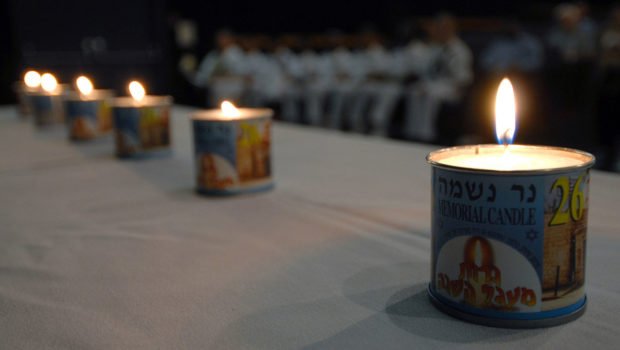When Will This End?
“How can this madness continue to go on?! When will it end?!” I thought to myself as I braced to hear and read about the latest in the horrible epidemic of gun violence which has gripped out country: this time in the Chabad synagogue in Poway, California, and at University of North Carolina in Charlotte, (where it was especially close as a dear friend and colleague was on campus, in the next building, less than an hour before the shooting). I am convinced that it won’t end by focusing on the individual perpetrators (their evilness, or sickness), but, like the contagious social virus it is, this plague needs to be seen as a sickness of our society.
Which means, as difficult as it is to admit, we are all inside of it, and it is inside of us. As Abraham Joshua Heschel wrote, while his own family members were being murdered in the concentration camps by the Nazis,
“Few are privileged to discern God’s judgement in history. But all may be guided by the words of the Baal Shem: If a man has beheld evil, he may know that it was shown to him in order that he learn is own guilt and repent, for what is shown to him is also within him.” (The Meaning of this War, 1944)
The epidemic of mass shootings is something that has become frighteningly normal, which is scary for all of us, but it has also lowered the threshold of those people in our society who could become shooters.
In a 2015 New Yorker article (Thresholds of Violence, October 12, 2015), Malcolm Gladwell makes the case for shifting our focus from the individuals who perpetrate horrific acts of violence such as mass shootings. He bases his thesis on Stanford sociologist Mark Granovetter. Granovetter studied the behavior of rioters, and took the step of shifting the focus away from the beliefs of individual rioters, to the dynamics of the group, the social processes. As Gladwell puts it:
Social processes are driven by our thresholds—which he defined as the number of people who need to be doing some activity before we agree to join them. In the elegant theoretical model Granovetter proposed, riots were started by people with a threshold of zero—instigators willing to throw a rock through a window at the slightest provocation. Then comes the person who will throw a rock if someone else goes first. He has a threshold of one. Next in is the person with the threshold of two. His qualms are overcome when he sees the instigator and the instigator’s accomplice. Next to him is someone with a threshold of three, who would never break windows and loot stores unless there were three people right in front of him who were already doing that—and so on up to the hundredth person, a righteous upstanding citizen who nonetheless could set his beliefs aside and grab a camera from the broken window of the electronics store if everyone around him was grabbing cameras from the electronics store.
Gladwell convincingly shows how Granovetter’s analysis can be extended to school shootings. He concludes:
“…the riot has now engulfed the boys who were once content to play with chemistry sets in the basement. The problem is not that there is an endless supply of deeply disturbed young men who are willing to contemplate horrific acts. It’s worse. It’s that young men no longer need to be deeply disturbed to contemplate horrific acts.”
So, if it’s no longer the extremely sick or evil, but rather just the lonely, the slightly unstable, or the easily influenced person, who could be the next shooter, what can we do?
In other words, how do we raise the threshold? How do we make it unthinkable again? One clear path is to make it harder to get a gun. The data from around the world is clear: the more guns the more likely it is that they will be used. We all need to commit to turning the tide on the politics of guns in this country. New Zealand’s horrible mosque shooting this year brought them to turn the tide and enact strict new gun laws. We must fight against the hopelessness and numbness of our many, many shootings, wake up and support new gun legislation. Here are a few places to do so. Write or call your congress person and call for the immediate passage of the Background Check Expansion Act. Support organizations such as March for our Lives: https://marchforourlives.com/, Giffords Law Center: https://lawcenter.giffords.org/ or other organizations fighting gun violence.
We also can raise the threshold of who will turn to gun violence by creating real life alternatives to the social media, online virtual echo chambers where (mostly) young men can get lost in radical, violent, alternative versions of reality; self-reinforcing, fringe sub-cultures of violence, resentment and blame. That is the difference between the kid a generation ago fiddling in the basement with his chemistry set and the lonely young man of today on their computer or phone.
The more we strengthen the frayed fabric of our communities, the more we can create real life connections with the people around us, the less likely it is for someone to fall between the cracks and be sucked down into a virtual whirlpool. It might be befriending your bagger at the grocery store, or talking to the neighbors when you walk the dog. Or it might be talking to another parent next time you’re waiting to pick up a kid from practice, instead of taking out your phone to check your email for the hundredth time. Maybe it’s growing some vegetables in your garden and sharing them with a neighbor.
We all want to protect our loved ones and live in communities, schools and workplaces in safety and security. We need to change the big picture through legislation, but we can also make a difference by changing our culture one person as a time; starting with ourselves and creating connected, loving and safe communities where everyone matters, where everyone, regardless of race, economic position, religion, gender or sexual orientation, knows that they are known and loved and cared for.
When the biblical prophet Elisha wanted to repay a woman from the region of Shunam for help she had given him he asked her what she needed. She indicated that she didn’t need anything, simply saying, “I live among my people.” When we all can say that; when everyone in our neighborhood is “my people.” When all our diverse schools and towns and cities provide the security of “living among our people,” then, perhaps we will see an end to this madness.







7 Responses to When Will This End?